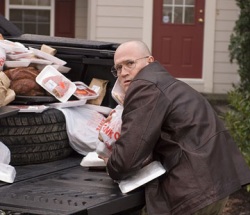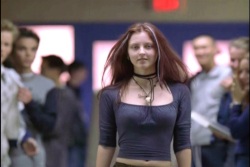Slither
 It’s admittedly unfair to want more from Slither than it’s willing to give, but I found the horror comedy from March too slight for the praise it got. Put simply: Slither lacked an agenda.
It’s admittedly unfair to want more from Slither than it’s willing to give, but I found the horror comedy from March too slight for the praise it got. Put simply: Slither lacked an agenda.
It might seem strange to demand that what’s meant as a throw-away entertainment have something to say, but the horror-comedy hybrid needs a reason for being. Pulled in different directions by two inherently incompatible genres, these movies tend to strive for individual effects – a chuckle here, queasiness there – rather than working toward coherence. The comedy undermines the horror, and vice versa. So I want something to hold my interest while those two genres duke it out.
Written and directed by James Gunn, the jokey Slither is Troma grown up and cleaned up, which is understandable, considering that Gunn wrote and produced Tromeo and Juliet.
The plot here involves a slug-like alien creature that chooses a shockingly bald and beefy Michael Rooker as its host. Rooker then terrorizes a small town’s animals, followed by its people.
Slither has its moments. I loved Rooker’s reading of the word “meat,” and a reference to A Streetcar Named Desire was not only funny but integrated into the fabric of the movie.
Beyond that, I found it tedious and pointless. (I should mention that it was the second half of a double feature at the drive-in, and I’m too damned old to start a movie at 11:20 p.m., let alone with an hour’s drive ahead of me.)
Of course, I’m not the target audience for Slither, because I’m picky in wanting things such as theme and three-dimensional characters. And in thinking about the movie, I tried to find some roughly equal mix of horror and comedy that genuinely worked for me. In defense of Slither, I thought of only one, which leads me to …
Ginger Snaps
 It’s a classic coming-of-age family drama. Ginger gets her first visit from Aunt Flo, and while her mother is overjoyed that her daughter is finally becoming a woman, younger sister Brigitte is troubled (and maybe a little jealous) that Ginger seems to be blossoming into a … errrr … werewolf.
It’s a classic coming-of-age family drama. Ginger gets her first visit from Aunt Flo, and while her mother is overjoyed that her daughter is finally becoming a woman, younger sister Brigitte is troubled (and maybe a little jealous) that Ginger seems to be blossoming into a … errrr … werewolf.
The Fitzgerald sisters of Ginger Snaps are already different. One class project involves graphic depictions of grisly (but inventive!) deaths. Although in high school, neither sassy Ginger (Katharine Isabelle) nor sullen Brigitte (Emily Perkins) has gotten her first period.
They have a vague pact – “Out by sixteen or dead in this scene but together forever” – that’s screwed up when Ginger gets attacked by something after she begins menstruating. Naturally (and unnaturally), her body and her hungers are changing, threatening her bond with her sister. Now, instead of loathing boys, she wants to screw them, then eat them.
The makers of Ginger Snaps largely play this premise straight. There are plenty of jokes and laughs – and the tone is certainly winking – but they never hijack the movie, grounded in the sisters’ relationship and culminating in Brigitte’s impossible choices at the climax.
Brigitte never rejects her sister. At least initially, she wants to cure Ginger, and when that plan goes awry, she infects herself, even though her motives are ambiguous and conflicted. As she laps up spilled blood, does she want to join her sister in lycanthropy to restore some common ground to their relationship, or is she trying to fool her? Why does Brigitte wield two weapons – a knife and a syringe with the cure – as Ginger prepares to pounce on her? And why does the younger sister not inject herself with the medicine that would return her to normal?
That earnest, sensitive, and serious interest in Brigitte’s and Ginger’s sisterhood holds this Canadian horror film together, making it a convincing and natural whole even though it combines a great number of disparate elements: gore, sexuality, thrills, ripe metaphors, social satire, broad comedy, and keenly observed teen angst. It features two lived-in lead performances alongside effective caricatures, and that juxtaposition doesn’t feel the least bit wrong. It’s the first movie I’ve seen that combines standard horror motifs and plots with the dysfunctional family and community dynamics (as well as the amused, detached style) of films such as The Virgin Suicides and Welcome to the Dollhouse. Karen Walton’s script is lean and rich, easily overcoming rubbery special effects and a director (John Fawcett) who’s merely serviceable.
In the way it links menstruation with fearsome girl power, the most obvious forebear of Ginger Snaps is Carrie, but a better comparison is George Romero’s fabulous (but virtually unseen) vampire movie Martin. Ginger Snaps shares that movie’s pathos and its understanding of the absurdity of horror conventions, and both use classic monsters to explore and heighten the conflict and confusion of puberty, sexuality, and alienation. Ginger’s transformation is obviously extreme, but it speaks meaningfully and truthfully to the ecstasy and fear that accompany discovering one’s changing body and what it can do.
Even apparent plot holes add meaning. When nobody notices Ginger’s fangs, or that dead dog on the playing field, it underscores the obliviousness of everybody, particularly the girls’ creepily cheery mother, Pamela (played by Mimi Rogers) – a running gag that’s consistent throughout the movie.
And even Pamela reveals depths near the end of the film, when she offers a shocking suggestion to Brigitte. That the girls’ mother would even consider what she says alters forever her relationship with her younger daughter, and gives Brigitte the assurance she needs to face her monster sister: the promise that she will never be alone, no matter what happens to Ginger.
That surprising but fair character shift illustrates how alive and multifaceted Ginger Snaps is, finding a human moment in a quiet ride before the carnage. The movie works as a comedy or a thriller, as pure story or a thematic and metaphoric exploration of budding sexuality, as a satire of the modern family or an earnest, touching sibling drama. It has a genuinely rare resonance.

